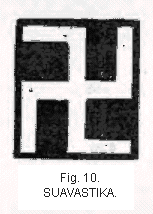

The Swastika
Definitions, Description & Origin
Quite another question is, why the sign of the Swastika should have had an auspicious meaning, and why in Sanskrit it should have been called Svastika. The similarity between the group of letters are in the ancient Indian alphabet and the sign of Svastika is not very striking, and seems purely accidental.
A remark of yours [Schliemann] (Troy, p.38) that the Svastika resembles a wheel in motion, the direction of the motion being indicated by the crampons, contains a useful hint, which has been confirmed by some important observations of Mr. Thomas, the distinguished Oriental numismatist, who has called attention to the fact that in the long list of the recognized devices of the twenty four Jaina Tirthankaras the sun is absent, but that while the eighth Tirhaukara has the sign of the half-moon, the seventh Tirthaukara is marked with the Svastika, i.e., the sun. Here, then, we have clear indications that the Svastika, with the hands pointing in the right direction, was originally a symbol of the sun, perhaps of the vernal sun as opposed to the autumnal sun, the Suarastika, and, therefore, a natural symbol of light, life, health, and wealth.
But, while from these indications we are justified in supposing that among the Aryan nations the Svastika may have been an old emblem of the sun, there are other indications to show that in other parts of the world the same or a similar emblem was used to indicate the earth. Mr. Beal * * * has shown * * * that the simple cross occurs as a sign for earth in certain ideographic groups. It was probably intended to indicate the four quarters- north, south, east, west-- or, it may be, more generally, extension in length and breadth.
That the cross is used as a sign for "four" in the Bactro-Pali inscriptions (Max Müller, "Chips from a German Workshop," Vol. II, p.298) is well known; but the fact that the same sign has the same power elsewhere, as, for instance, in the Hieratic numerals, does not prove by any means that the one figure was derived from the other. We forget too easily that what was possible in one place was possible also in other places; and the more we extend our researches, the more we shall learn that the chapter of accidents is larger than we imagine.
The "Suavastika"which Max Müller names and believes was applied to the Swastika sign, with the ends bent to the left (fig.10),
 seems
not to be reported with that meaning by any other author except Burnouf.
(2) Therefore the normal Swastika
would seem to be that with the ends bent to the right. Burnouf says the
word Suarastika may be a derivative or development of the Svastikaya,
and ought to signify "he who, or, that which, bears or carries the
Swastika or a species of Swastika." Greg, (3)
under the title Sovastikaya, gives it as his opinion that there is no
difference between it and the Swastika. Colonel Low (4)
mentions the word Sawattheko, which, according to Burnouf (5)
is only a variation of the Pali word Sotthika or Suvatthika, the Pali
translation of the Sanskrit Swastika. Burnouf translates it as Svastikaya.
seems
not to be reported with that meaning by any other author except Burnouf.
(2) Therefore the normal Swastika
would seem to be that with the ends bent to the right. Burnouf says the
word Suarastika may be a derivative or development of the Svastikaya,
and ought to signify "he who, or, that which, bears or carries the
Swastika or a species of Swastika." Greg, (3)
under the title Sovastikaya, gives it as his opinion that there is no
difference between it and the Swastika. Colonel Low (4)
mentions the word Sawattheko, which, according to Burnouf (5)
is only a variation of the Pali word Sotthika or Suvatthika, the Pali
translation of the Sanskrit Swastika. Burnouf translates it as Svastikaya.ENDNOTES:
1. "Ilios," p. 348. [Back]
2. "Lotus de al Bonne Loi," App. viii, p.626, note 4. [Back]
3. Archueologia, p.36. [Back]
4. Transactions of the Royal Asiatic Society of Great Britain, iii,p.120. [Back]
5. "Lotus de la Bonue Loi," App. viii,p.625, note 2. [Back]
<< Previous Page Next Page >>
© 2004-2007 Northvegr.
Most of the material on this site is in the public domain. However, many people have worked very hard to bring these texts to you so if you do use the work, we would appreciate it if you could give credit to both the Northvegr site and to the individuals who worked to bring you these texts. A small number of texts are copyrighted and cannot be used without the author's permission. Any text that is copyrighted will have a clear notation of such on the main index page for that text. Inquiries can be sent to info@northvegr.org. Northvegr™ and the Northvegr symbol are trademarks and service marks of the Northvegr Foundation.

|